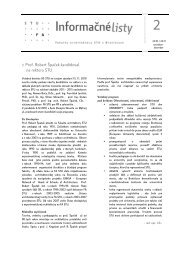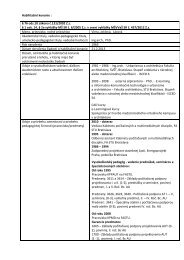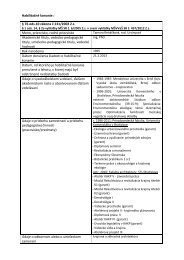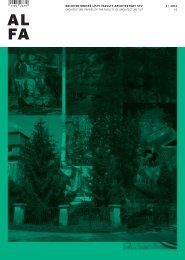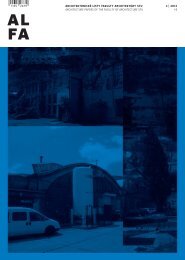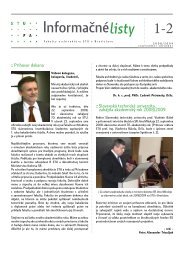ALFA 3-4/2005 - Fakulta architektúry STU
ALFA 3-4/2005 - Fakulta architektúry STU
ALFA 3-4/2005 - Fakulta architektúry STU
Create successful ePaper yourself
Turn your PDF publications into a flip-book with our unique Google optimized e-Paper software.
Ročník 9<br />
3-4 / <strong>2005</strong> ARCHITEKTONICKÉ LISTY FA <strong>STU</strong><br />
INTRODUCTION<br />
Hospice is an alternative to the medical center with its cold<br />
architecture and emphasis put on procedures. It indicates a place<br />
centered or focused on the patient. It is a place that exists for<br />
the patient, not for procedures. Hospice is an alternative way to<br />
plan a place for terminal-ill patiens reconsidering the needs of<br />
the dying person and then fashioning a setting and required<br />
support areas around the patient and these defined needs.<br />
The challenge is to create an environment that allows and assists<br />
the search for meaning in life for each individual. Home-like<br />
settings have become a topical subject in health care design.<br />
THE TOPIC OF THE WORK<br />
. The humanization of the hospital environment with<br />
the emphasis on the missing items in the health service<br />
system – hospice.<br />
. Hospice is comprehensive care in the last months of life.<br />
It is a special concept of care designed to provide<br />
comfort and support to patients and their families when<br />
a life-limiting illness no longer responds to cure-oriented<br />
treatments.<br />
. The goal of hospice care is to improve the quality of<br />
a patient's last days by offering comfort and dignity.<br />
. Hospice care is provided by a team-oriented group of<br />
specially trained professionals, volunteers and family<br />
members.<br />
. Hospice addresses all symptoms of a disease, with<br />
a special emphasis on controlling a patient's pain and<br />
discomfort.<br />
. Hospice deals with the emotional, social and spiritual<br />
impact of the disease on the patient and the patient's<br />
family and friends.<br />
THE MAIN THEMES OF THE WORK<br />
. To design logical units and disposition relations of<br />
the new typological classes – the hospices for adults, for<br />
children, pure and combined hospices, universal or<br />
specific hospices.<br />
. To define new possibilities for development of hospices<br />
in Slovakia.<br />
THE ACTUAL SITUATION OF THE PROBLEM<br />
Hospice - the situation in health service in Slovakia<br />
According to the health service statistics from the year 1995<br />
more than 500.000 inhabitants in Slovakia suffer from chronic<br />
Monika BALAROVÁ<br />
HOSPICE<br />
- 47 -<br />
diseases. There are 6 hospitals for long-term ill patients in<br />
Slovakia with 600 beds and the possibility of the acceptance<br />
of 3534 patients within a year. The hospitals for long-term ill<br />
patients do not satisfy the standards in compliance with definition<br />
of The World Health Organization (WHO) and with the basic<br />
principles of palliative care. One of the standards is also an aspect<br />
of architecture.<br />
The basic cells of the hospice care in Slovakia are parish and see<br />
charities. They propagate the hospice care and they try to change<br />
an attitude of public towards dying people. The hospice movement<br />
starts to work in terrain – directly in families, because a family is<br />
the most natural, social and emotional background for everyone.<br />
That is a place where “ADS“ – The Agencies of Home Care start<br />
to work. They offer the service of professional charity nurses and<br />
social workers. In the case when health care service is necessary<br />
(reduction of pain) patients can use the service of “ADOS“ –<br />
The Agencies of Home Nursing Care. The founding of ADOS is a<br />
competence of the town / village according to the law 416/2001.<br />
In the public notice 770/2004 Ministry of Health Care established<br />
a mobile hospice as an health service institution of<br />
the ambulant health care and a hospice as an health service<br />
institution of the institutional health care. The law 578/2004 says<br />
that hospice provides palliative health care.<br />
There should be built a network of „pure“ hospices in Slovakia in<br />
the future. But the present-day situation is not encouraging. There<br />
is only one pure hospic in Slovakia now and there are several<br />
buildings reconstructed in order to found there a hospice (for<br />
example: Bardejovská Nová Ves, Bratislava, Trstice).<br />
Hospice – is a missing item in the system of health care<br />
in Slovakia.<br />
The cultural heritage and traditions<br />
Formal religion and view of spirituality, focused on existential<br />
issues have had a strong influence on the ethical and moral basis<br />
of European palliative care. Some palliative care founders have<br />
been opposed to euthanasia, whereas others look for a degree of<br />
accommodation between two radically different approaches to<br />
end-of-life issues. Across Europe, what counts as the ‘good death’<br />
also varies, from the slow slipping away of the senses which<br />
the Spanish call “agonia“, to the conscious awareness of<br />
Northern Europe. Likewise, there are different cultural<br />
assumptions about so-called ‘truth telling’ and about the nature of<br />
‘autonomy’.<br />
Traditions – that is a very strong aspect for establishing of hospice<br />
in Slovakia. People are used to take care of their old and ill



